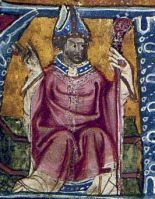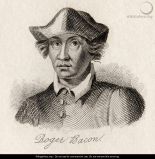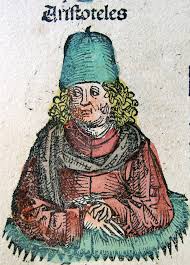The second part of the written part of my Special Comprehensive Exam takes us back to the Middle Ages. It proves that by no means it was a dark age, and that the modern science has its important predecessors in those working in the field of natural philosophy at that time. My summary gives a small insight into the complexity of their ideas, and the importance of the causal reflection in their explanations.
Causality in Middle Ages
The first important center of science and philosophy in Middle Ages was located in Oxford. Its main representatives followed the Pythagoreans and Plato, fostering mainly the mathematical component. They searched for explanations in mathematical terms, trying to relate them to Aristotle’s causality.
 One of the first thinkers of that school, Robert Grosseteste (ca. 1168-1253), who tried to emphasize both the role of mathematics and the indispensability of experience and experiments (“in thought if not in deed”), which are supposed to verify or falsify the outcomes of physics. But he did not present any procedure of verification. It is also doubtful that he made real experiments. He would value a demonstration involving all four causes, but he thought they should be somehow quantifiable and amenable to mathematical treatment. (He presents an analysis of four causes of thunder: 1) the formal cause is “rumbling sound in clouds,” 2) the material cause is “quenching of fire in cloud,” 3) the efficiency involved is described through the mechanism that produces the thunder (clouds, vapor, fire in air), 4) the final cause (according to Pythagoreans) is to terrify those detained in the infernal regions.)
One of the first thinkers of that school, Robert Grosseteste (ca. 1168-1253), who tried to emphasize both the role of mathematics and the indispensability of experience and experiments (“in thought if not in deed”), which are supposed to verify or falsify the outcomes of physics. But he did not present any procedure of verification. It is also doubtful that he made real experiments. He would value a demonstration involving all four causes, but he thought they should be somehow quantifiable and amenable to mathematical treatment. (He presents an analysis of four causes of thunder: 1) the formal cause is “rumbling sound in clouds,” 2) the material cause is “quenching of fire in cloud,” 3) the efficiency involved is described through the mechanism that produces the thunder (clouds, vapor, fire in air), 4) the final cause (according to Pythagoreans) is to terrify those detained in the infernal regions.)
 Roger Bacon (ca. 1214-1294) was a disciple of Grosseteste. He claims that mathematics is not only essential for understanding all sciences. Without it we are not able to understand the world. Although, following his teacher, he states that mathematical reasoning must be supplemented by experience to make its intuitions certain, it is again questionable whether he performed real experiments. But it needs to be noticed that he, supported by John Peckham (ca. 1230-1292), brought an important contribution to optical sciences (even if their appeal was more towards experience than experimentation). They were also committed to a realist philosophy of science and were looking for causes of phenomena.
Roger Bacon (ca. 1214-1294) was a disciple of Grosseteste. He claims that mathematics is not only essential for understanding all sciences. Without it we are not able to understand the world. Although, following his teacher, he states that mathematical reasoning must be supplemented by experience to make its intuitions certain, it is again questionable whether he performed real experiments. But it needs to be noticed that he, supported by John Peckham (ca. 1230-1292), brought an important contribution to optical sciences (even if their appeal was more towards experience than experimentation). They were also committed to a realist philosophy of science and were looking for causes of phenomena.
 The 14th century science at Oxford further questioned realism and remained under the influence of the nominalism of William of Ockham (ca. 1287-1347), who would challenge the reality of Aristotelian “common natures.” Terms such as quantity, motion, time, space, velocity and causality, had for him no other real referents than an individual substance. In this situation only the mathematical approach was able to survive (it developed analyses similar to those employed in 17th century science), while the experimental and causal components were somehow neglected. This turn brought a development of calculatory techniques and kinetics. Indeed, it was the Medieval Oxford where an important development of the philosophy of motion was reached by a series of thinkers such as: Ockham, who associated motion with successive positions of body in motion (res relativa, forma fluens); Walter Burley (ca. 1275-1344), for whom motion was res successiva, that is something real, over and above moving object, having its causes and effects (not only forma fluens but also fluxus forme); Thomas Bradwardine (ca. 1290-1349), who equated motion with “speed of motion,” and thus brought a mathematization of motion; William Heytesbury (before 1313-1372/73), who introduced important kinematical rules called “mean-speed theorem;” and Richard Swineshead (fl. ca. 1340-1354), who is associated with an anonymous Tractatus de motu locali difformi, in which we find a description of four causes of local motion: “the material cause of motion, or the matter of motion, is whatever is acquired through motion; the formal cause is a certain transmutation conjoined with time; the efficient cause is a ratio of greater inequality of the moving power over resistance; and the final cause is the goal intended.”
The 14th century science at Oxford further questioned realism and remained under the influence of the nominalism of William of Ockham (ca. 1287-1347), who would challenge the reality of Aristotelian “common natures.” Terms such as quantity, motion, time, space, velocity and causality, had for him no other real referents than an individual substance. In this situation only the mathematical approach was able to survive (it developed analyses similar to those employed in 17th century science), while the experimental and causal components were somehow neglected. This turn brought a development of calculatory techniques and kinetics. Indeed, it was the Medieval Oxford where an important development of the philosophy of motion was reached by a series of thinkers such as: Ockham, who associated motion with successive positions of body in motion (res relativa, forma fluens); Walter Burley (ca. 1275-1344), for whom motion was res successiva, that is something real, over and above moving object, having its causes and effects (not only forma fluens but also fluxus forme); Thomas Bradwardine (ca. 1290-1349), who equated motion with “speed of motion,” and thus brought a mathematization of motion; William Heytesbury (before 1313-1372/73), who introduced important kinematical rules called “mean-speed theorem;” and Richard Swineshead (fl. ca. 1340-1354), who is associated with an anonymous Tractatus de motu locali difformi, in which we find a description of four causes of local motion: “the material cause of motion, or the matter of motion, is whatever is acquired through motion; the formal cause is a certain transmutation conjoined with time; the efficient cause is a ratio of greater inequality of the moving power over resistance; and the final cause is the goal intended.”
The other center of medieval philosophy and science was located in Paris and remained in an opposition to Oxford. Its main thinkers did not trust mathematics as much as the empirical temper of Aristotelian tradition (rediscovered at the University of Paris). They believed in man’s ability both to come to know the world of nature and to discover and name the causes of its phenomena. Thus, it was the academia in Paris that gave start to the reflection on dynamical problems, supporting the origin of a systematic science of mechanics, which already had its kinematic component established at Oxford.
 The philosophical foundation of the Paris movement was offered by Albert the Great (1193/1206-1280) and his ingenious pupil Thomas Aquinas (1225?-1274). The first one of them, a leading scientist of his time, emphasized the role of observation and empirical reasoning. He saw the object of mathematics being an abstracted entity rather than an ontologically antecedent form. He emphasized the importance of the search for causes of natural things in the oft quoted passage from his De cello et mundo in which he says that: “In natural science we do not investigate how God the Creator operates according to His free will and uses miracles to show His power, but rather what may happen in natural things on the ground of the causes inherent in nature.”
The philosophical foundation of the Paris movement was offered by Albert the Great (1193/1206-1280) and his ingenious pupil Thomas Aquinas (1225?-1274). The first one of them, a leading scientist of his time, emphasized the role of observation and empirical reasoning. He saw the object of mathematics being an abstracted entity rather than an ontologically antecedent form. He emphasized the importance of the search for causes of natural things in the oft quoted passage from his De cello et mundo in which he says that: “In natural science we do not investigate how God the Creator operates according to His free will and uses miracles to show His power, but rather what may happen in natural things on the ground of the causes inherent in nature.”
Aquinas’ great contribution was his explanation of the way in which all four causes can be used in the demonstration in natural science. In his commentaries on major philosophical works of Aristotle Aquinas brings important development of the theory of four causes. He lists four types of formal causality, and introduces the distinction between essentia (essence, Aristotelian prime matter informed) and esse (existence). Following Avicenna, he defines four types of efficient causation and introduces important distinctions between principal/instrumental, and primary/secondary causes. He explains the way in which one thing can have many per se causes, cases of reciprocal causation, and those of things being causes of contrarieties. He also develops Aristotle’s reflection on the modes of causation, and provides an important commentary on Philosopher’s doctrine of necessity and chance. He shows that the problem of a chance event described in terms of two lines of causality crossing at a certain point of time and space cannot be resolved by tracing back each line of causality. Such operation will not provide an answer to the question of the proper (per se) cause of a chance occurrence.[1]
Developments of philosophy of causation presented by Albert the Great and Thomas Aquinas encouraged others to embrace more consciously and ardently philosophical realism in their science. Peter of Maricourt (fl. 1269) was a great experimenter who named magnet’s poles after the celestial poles and developed a methodology of falsification. Theodoric of Freiburg (ca. 1250-1310) who was a Dominican Friar concentrated himself on the search for the causes of rainbows and radiant phenomena. Although he emphasized the importance of all four causes in scientific explanation, he concentrated mainly on material and efficient causes. In his study of rainbows, he made an attempt on duplicating natural processes under controlled conditions, and thus gave the foundation to laboratory experiments. He also challenged Aristotle proposing his own use of induction which brings him closer to the modern experimental method than anyone else at his time.
The condemnations of Aristotle of 1270 and 1277 in Paris gave a fresh impulse to construct new hypothetical schemata for “saving the phenomena.” This brought a new realist analysis of local motion, developed by Jean Buridan (ca. 1310-after 1358), who claimed that it is real and independent of the thing moved and the place, and spoke of a virtus derelicta (“force left behind”) which he called impetus; Albert of Saxony (ca. 1316-1390), who speculated on the doctrine of impetus and the cause of the acceleration of falling bodies; and Nicole Oresme who would address the same problems in his writings. Interestingly enough, all three of them sowed seeds of the Copernican revolution, saying that both the hypothesis of earth in rest and the one with earth in motion, save the phenomena (but they refused to develop the second opinion). Oresme was also the first to develop an analogy between the workings of a clock and the universe, the analogy which would return and become very powerful with the mechanical turn in science.
Middle Ages brought one more opinion on causality, which remained in a radical opposition to the developments proposed in Oxford and Paris. Medieval occasionalism, linked to kalām, which is a type of philosophizing in Islam, developed by Al-Ash‘arī (d. 935) and Al-Ghazālī (1058–1111), denied any kind of causation in creatures, attributing it to the only true agent, God. This position was opposed by Averroes and Aquinas who argued that it deprives natural things of the actions that belong to them.
This story shows the ways in which the philosophy of causation, which had its roots in antiquity, was developed in Middle Ages. This movement prepared the stage for the Renaissance and the origin of the classical science, philosophy, and methodology which brought a dramatic change in philosophy of causation and more generally in philosophy of nature and metaphysics. I will describe them in the third episode which will be coming soon. 🙂








 origin of scientific endeavor in antiquity.
origin of scientific endeavor in antiquity.



